[Welland-Port Colborne Evening Tribune, 23 January 1947]
It is a credit to the Welland County General hospital that it has gained provisional approval in the listings of the American College of Surgeons for 1946. Each year the listings contain hospitals in the United States and Canada which have compiled satisfactorily with the fundamental requirements that assure the best care of the sick and injured.
Provisional approval indicates a hospital which is trying to meet the requirements of the college, but for acceptable reasons has not been able to do so in every regard.
The hospitals of both countries are reconsidered each year, and as wartime difficulties have disappeared the standards are higher. In 1946, 3,118 hospitals qualified-a decline of 63 from the year before.
Dr. Irvin Abell, president of the college’s board of regents, explained this as a “sinking into post-war lethargy”. He said the college expected hospitals to be “leaders in the post-war effort to improve every type of welfare service.”
The citizens of a community are held responsible for insisting upon good hospital service and for giving the support and encouragement need to provide it. The two problems now facing hospitals are inadequate nursing staffs and untrained administrators.
The College of Surgeons appeals to schools and community institutions to stimulate recruiting of student nurses. It suggests that the public can see that hospital administrators appointed are men who understand both the professional and business problems of a hospital.
Niagara peninsula hospitals did well in the ratings. Fully approved were the Niagara Peninsula Sanatorium and St. Catharines General hospital. The Niagara Falls hospital was provisionally approved.
The requirements for approval include the following fundamentals: modern physical plant, clearly defined organization, carefully selected governing board, competent, well-trained superintendent, adequate and efficient personnel, organized medical staff, adequate diagnostic and therapeutic facilities, accurate and complete medical reports for research, regular group conferences of the administrative and medical staffs, and a humanitarian spirit-“the primary consideration being the best care of the patient.”
Newest Addition Will Be In Corrugated Steel; Lean-to Planned
READY IN MARCH
[Welland-Port Colborne Evening Tribune, 1 February 1940]
Foundation pillars have already been laid for the erection of a new corrugated steel sheeting warehouse and lean-to on East Main street for Atlas Steels Limited, according to plant officials. The new building will be completed toward the end of March, and will cost approximately $18,000. It will be on similar lines to the rolling mills for which a building permit was issued in December to the value of $14, 675.
Standard Steel Construction Company Limited of Port Robinson will have the contract. The building will have a frontage on East Main street of 100 feet with a depth of 157 feet, it was learned.
This is to be a storage building and will not involve any additions to the payroll, The Tribune was informed. The warehouse will be 80 feet frontage, with a depth of 157 feet, and the lean-to will have a frontage of 20 feet and a depth of 157 feet.
[Welland Tribune, 27 August 1897]
DUNNVILLE knocks Welland out on electric light prices. The electric light plant there is run by a private company, and run right up to date. An all night service is given the year round, and consumers can have a single light for seven cents a week; over ten lights, six cents per week each; and over twenty lights, five cents per light per week. The electric light station is a fine brick structure set on massive stone walls-a credit to the place. Messrs. Haskins & Ralston are the owners, and when asked if there was any money in it at these figures, cautiously and smilingly remarked that they managed to pay their way and have a little pin money to the good. The company have between 800 and 900 lights, and their machines have a capacity of about 1500. Incandescents are being tried at certain points along the main streets and give a promise of working well.
N.S. and T. Car Hits Back End of Automobile at Lincoln Crossing
NEAR MIDNIGHT
[Welland Tribune, 27 January 1940]
As a result of a rail crossing collision between a car being driven east along Lincoln street west at 11.15 last night and a south-bound trolley operated by Motorman Alfred Clup of St. Catharines, four persons were injured and brought to the Welland County General hospital. Three were detained.
The injured were Miss Marion Flick, 18, of Oakland avenue, concussion and shock; Edward Richardson, 22, of Mill street, deep cut over left eye and shock; Thomas Blackwell, 29, of Wilton avenue, fracture to the right collar bone and shock; Sydney Bretell, 50 Cohoe street, driver of the automobile, cut over the left eye and shock. Bretell was able to go home following treatment to his left eye.
According to the report of the mishap given to Constable George Hatton by Motorman Culp, the trolley had just left the Welland N.S and T. station, and was proceeding south. Approaching the Lincoln street crossing, Mr. Clup said he blew the warning whistle. The driver of the car appeared to slow up and then speed toward the crossing, he said. The auto didn’t clear the crossing in time to avoid a crash and the trolley struck the automobile at the left read side where Miss Flick was seated.
According to the police accident report, Sydney Brettel stated that he failed to either see the trolley or hear its whistle until too late to avoid the mishap. He further stated that by stepping on the gas he avoided a more serious accident.
The left rear wheel, left door and windows of the automobile were smashed, according to police.
S. S.. 4, Pelham
Welland Road, near Haisr Rd.
[Pelham Historical Calendar 1983]
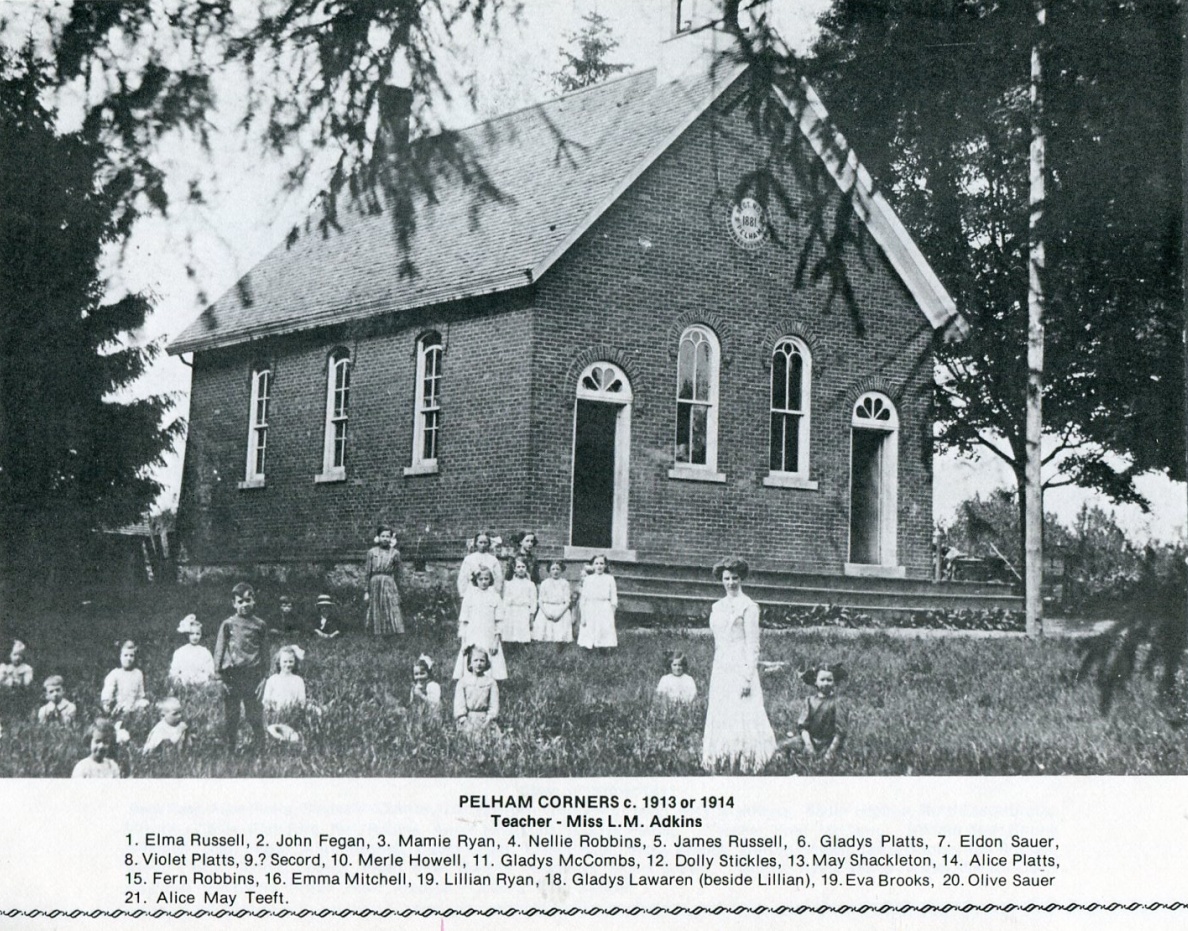
As early as 1835 there was a community sufficiently large to be recorded as the “Village of Pelham Corners.”
A school was a necessity. Samuel Rice set aside one-half acre (part of his property) in the south-west part of lot 3, Concession 9, on Sept 11, 1865, “for the purpose of establishing a school house and a teacher’s residence.”
More than four years elapsed before the trustees registered this transaction on Feb 4, 1870, in the name of School Section No. 4 Pelham, It is a matter of conjecture why the matter took so long, for the cost of the property was only $62.50, not a princely sum even then.
A brick school house of conservative design was built in 1881, although there are indications that a previous classroom was set up before that, in the building that later housed the Brasford family and then Mr. and Mrs. Wm. Weed, and was relinquished when this school building was finished. Due to an ever-increasing enrolment an addition was constructed on the front of the brick school in 1950, and in three to five years, an extension was again necessary. An ample playground and a quiet neighbour round out the picture.
An early teacher on record was a Miss Wilson, whose salary in 1888 was listed as $250.00 per annum. One teacher bears very special mention, and that is Miss Mabel Stirtzinger who began teaching there on January 3 1918, and remained there until the Christmas holidays in 1931. Some years later, she returned.
Mr. Haggerty of Pelham Corners has only high praise for her. While he was her pupil he remembers a very dark morning when there was a terrific wind. As there was no hydro in the school, the classroom became very gloomy and the situation rather frightening. Miss Stirtzinger diverted her pupils’ attention away from the storm by quietly reading to them. On the way home that day Harry learned that the wind had blown the roof off the north-west corner of the Quaker Church.
Pelham Corners was a one-Room school until 1950, with forty to forty-five pupils on the average. With eight grades, that was a handful for any teacher, but Mr. Haggerty feels that it provided an incentive for the pupils to “get ahead” when they saw what the older grades were doing. He could be right. He mentioned that the furnace had a circular tray around the base of it which required a gallon of water a day. The children considered it an honour to be asked to fill it. The older children went in pairs to bring in the coal, another privilege. Work was its own reward.

Prior to this, Mrs. Richard Liebau also attended this school. She remembers the box stove, and the boys bringing in the cordwood. In the girls’ entry there was one wash basin and one linen towel. The lunches were placed on a shelf there, resulting in an occasional frozen dinner.
It was so cold in the school overnight that the ink often froze, which was very unhandy. The first pump had a bucket with chains on it. Sometimes the chain broke, in which case Mr. Frank Muirhead was called upon to fix it. He was their good stand-by when anything mechanical went wrong. In spite of all these difficulties, the wheels of education still turned faithfully around.
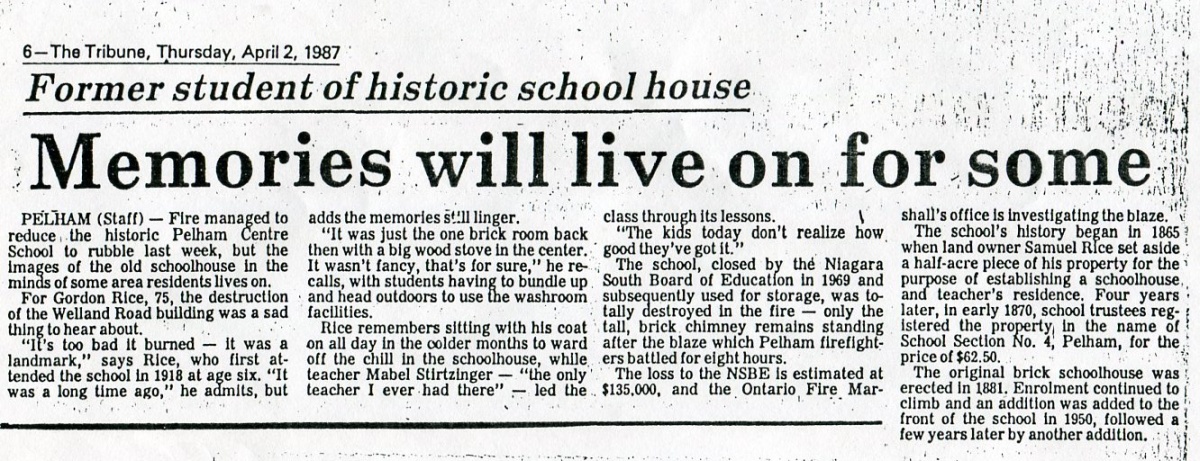
In 1970, the school was closed, with Mrs. Laurena Brouwer as principal of the four classrooms. She had very capably served Pelham in that school for ten years. At present, the schoolbuilding is used for storage. The lawn is well kept, but the school yard looks very lonely.
Catherine B. Rise
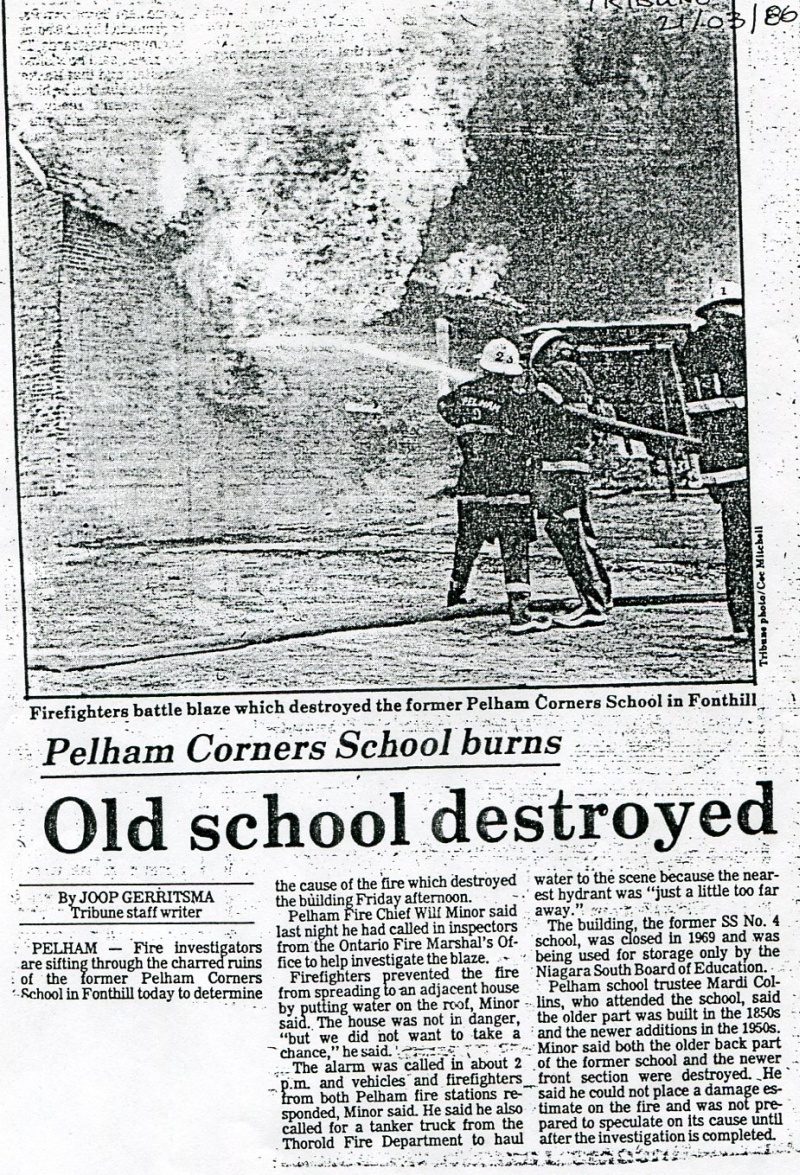
ICE JAM REDUCES IT TO A WHISPER-ENTIRE FLOW MAY BE CUT OFF
[Welland Tribune, 18 January 1940]
Niagara Falls, N.Y., Jan.18-An ice jam in the Upper Niagara River reduced the roar of Niagara Falls to a hoarse whisper today.
Tracey Levee, chief of the Niagara Reservation Police, estimated the flow over the American Falls had been reduced 60 percent, while the Bridal Veil Falls were slowed to a trickle.
Meanwhile the ice bridge over the Canadian Horseshoe Falls extended from the foot of that cataract to a point just below the site of the “Honeymoon” Bridge, destroyed by ice in January 1938.
Rivermen predicted that if near zero temperatures and the run of Lake Erie ice continues, the entire flow over the Falls may be cut off. This occurred in the winter of 1936, when it was possible for a brief period to walk across the brink of the American Falls from the mainland to Goat Island.
124 MORE WERE IN USE THAN IN 1938, COMPANY REPORT REVEALS
[Welland Tribune, 19 February 1940]
R.D. Hughes, manager of the bell Telephone Company in Welland, has handed to The Tribune a statistical report which shows that an increase of 124 was recorded in the number of telephones in the city in 1929 compared to that of the previous year. The total number in use was 2,277 in 1938 and 2,401 in 1939.
Mr. Hughes sated that if as some authorities contended, the number of telephones in a community formed an excellent barometer of general business, than it would seem that Welland was continuing to progress from this standpoint.
Continuing, Mr. Hughes stated that offices supervised from Welland showed a net gain in the number of telephones of 284, divided as follows: Welland, 124; Port Colborne, 118; Ridgeville, 22; Smithville, 4; Wainfleet, 14; Wellandport, 2. This entire territory, he added, now had a total of 5,293 telephones in service.
Mr. Hughes showed The Tribune the Bell Telephone Company’s annual report for Ontario and Quebec, recording a total of 785,455 bell telephones in use in these two provinces at the end of the year. The records showed a net gain of 20,000 telephones compared with a net gain of 18,804 the previous year. During the year the company paid out $16,928, 825 in wages to its 9,711 employees, 5-825 in wages to its 9,711 employees, 5,008 of whom are women.
The report notes that the number of telephones recorded for 1939 is “an all- time high for Ontario and Quebec.”
[The following was composed by Mrs. A.M. Phillips and some of the board members of this school prior to its closing. Mrs. Phillips was at one time a teacher at this school.]
The first record to be found of the O’Reilly’s Bridge School is for the year 1847 but according to this record, there was a school in this district previous to that date, known as No. 6 Wainfleet and No. 5 Pelham.
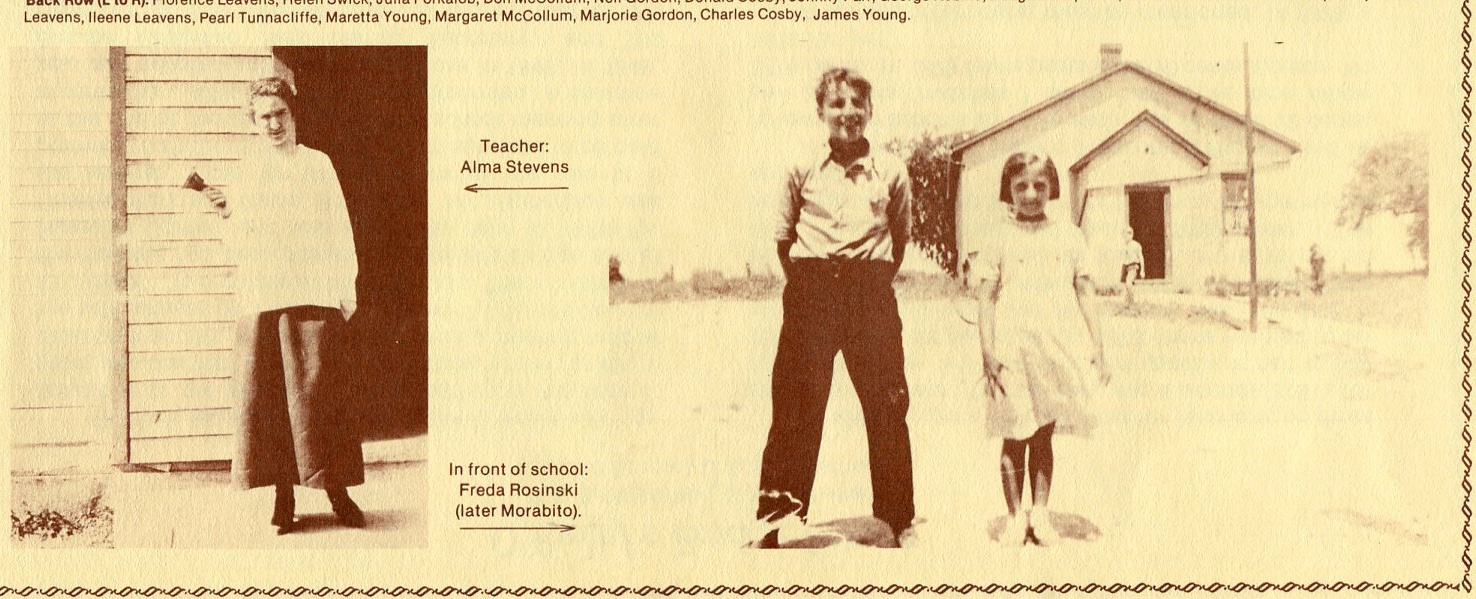
The invitation to organize a Union section read thust:”A meeting is to be held in O’Reilly’s Bridge School house for the purpose of organizing a Union Section and electing three fit and proper trustees.” Those present at this meeting were: Robert McCormick, John B. O’Reilly, Peter Jennings, Robert Simcoe Chapman, Alex B. Chapman, Wm. Bunts, Charles Parks, Sayers Hagar. Trustees elected were: John O’Reilly, Sayers Hagar,, Charles Park, who was to be the Sec.-Treas.
The first teacher to be hired by the above board was Mr. Gavin Robertson for three months at the rate of 5 pounds 10 shillings per month.
The contract read: “We do hereby contract and employ Gavin Robertson at the rate of 5 pounds 10 shillings($240. Per year) and we further bind ourselves and our successors in office to faithfully employ the powers with which we are legally invested, by said section, and said act to collect and pay said teacher. Which sum is to be paid at the expiration of the term.”
The first school meeting after organization was held in Jan. 1847. The chairman was John Phillips. A common seal was adopted and was ready to use in 1848. In 1849, Simcoe Chapman was name secretary and his penmanship was worthy of note.
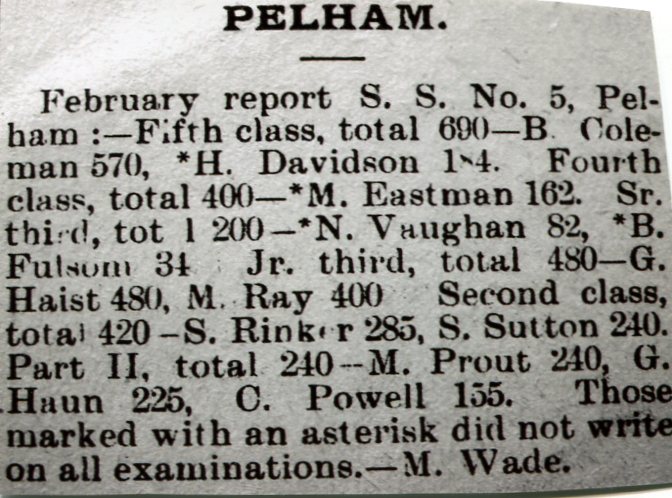 The second teacher was Paul Marlott at 5 pounds 10 shillings per month but was to be paid quarterly. The third teacher was one Sarah Chapman at 42 pounds per annum and the fourth was Edward Henry at 5 pounds 10 shillings per month.
The second teacher was Paul Marlott at 5 pounds 10 shillings per month but was to be paid quarterly. The third teacher was one Sarah Chapman at 42 pounds per annum and the fourth was Edward Henry at 5 pounds 10 shillings per month.
In 1849, Peter Jennings became the new trustee and Sayers Hagar became the new Sec,-Treas. (More notable penmanship here.) In 1850, the following resolution was passed: “Moved by Mr. C. Park, seconded by A.B.Chapman that the school now in use in said section is in a very delapidated state and also very small; is not sufficient to make the children comfortable or in any way answer the demands of the section; it is therefore resolved that a new school house be built at O’Reilly’s Bridge as soon as possible—to raise funds 1 by public subscription 2 or by taxing all section owners alike. The discussion re what method to be used waxed rather warm apparently. Finally a combination method was adopted.
It was decided that said school was to be erected on a rise of land on the southmost part of Lot 7 of the Township of Pelham bordering on the Chippawa River Road. The trustees were to examine several other schoolhouses to decide how best to direct the building of the new schoolhouse.
In 1852, Wm. Phillips became a new trustee and John B. Henderson became the new secretary. At a meeting in 1852, it was moved by Mr. Chapman and seconded by Mr. O’Reilly that the old school be sold instantly and that proceeds were to go to 1 pay off debts 2 to pay for a new stove and pipe for the new school 3 balance if any to be applied to purchasing new apparatus deemed necessary for the new building.
Then and there Sayers Hagar became salesman for the old school. It was cried off to the highest bidder at 10 pounds 10 shillings to John B. O’Reilly.
During the year 1852-53, several school meetings were held in early candle light to determine whether it was to be 1 Free School 2 Direct Taxation. Three votes taken. The results were: 1. 3–11, 2, 4–11, 3. 15-15.
The chairman broke the tie in favour of direct taxation. Here a few pages are missing from the record but according to the financial report, the new school (the present one) must have been built in 1853. It is difficult to estimate the cost from records as much work was done gratis by members of the section-some bringing timber, some glass, some cement, etc.
Walter Henderson succeeded Edward Henry as teacher in 1853, followed by Bridget May Kelly in 1854. Walter H. Received 60 pounds, Bridge May 30 pounds, This gives a good contrast of male and female teacher’s salary. Bridge May asked for a raise of 5 pounds; this was refused; and apparently she left in 1855. J. Winters became the next schoolmaster at a salary of 90 pounds and 5 pounds for equipment.
In 1856, John Phillips became the new trustee and Archie Cumming was hired as teacher at 90 pounds per annum. To raise funds in those days they charged one third pound per child per month or approximately one dollar and fifty cents per month, the remainder being raised by voluntary subscriptions.
In 1856, it was difficult year for teachers, as three served in one year, namely-Robert Lamont, Azabah Hagar and Marjorie Rich.
During this year cordwood was purchased for $1.50 per cord.
In 1857, Andrew Martin became the new trustee and the schoolmaster was Chas Pennington. His contract read: “Chas. Pennington hired for $25 per month, said teacher contracts and binds himself to teach and conduct the school in said section—etc. And to be perfectly temperate during his engagement under pain of forfeiture of his wages, (Chas. Must have been as good as his word for a short time. Then was off-duty and re-hired for a period of two years. Mr. Pennington was another who was outstanding for his penmanship. He apparently became Secretary also for his term of office.
During 1860, Mr. Peter McCollum was elected as trustee. Mrs Henry Cram was school teacher at an annual wage of $264.
In 1861, Mr. Jas. Lawrence became schoolmaster and in 1862, Munroe Howland, each at $18 a month.
In 1863, the first auditors came and it also brought assessment by direct tax on property. But still each child was assessed 25 cents per month. And this was collected by the teacher and an account given to the board.
Miss Emma Gilchrest taught in 1869 at $192 per annum and her successor was Miss Hampton at $16 per month.
During 1873, a discussion took place re the removal of the school to another location but the motion was turned down flatly. In 1873, Miss Julie Price taught one month on approval-was found satisfactory and was engaged for the year at $240.
In 1874, the board of Trustees consisted of Andrew Melick, Geo. Eastman, Wm Phillips with S. Jennings as Sec. Treas. These served until 1877 when Mr. Melick was replaced by Mr. Clarke McCollum, Richard Farr and Jas, Armstrong became trustees in 1879 and served until 1885 when Mr. Poth and Mr. Misener were added to the Board.
In 1887, Mr. Van Wyck became trustee and Mr, Clarke McCollum the secretary. During the year 1889, Mr. Norman McClellan became the secretary and Mr, Weallens the new trustee.
An agreement of interest in 1889 read thus:” We hire Mr. Howard Kenned as teacher, He is to put on fires, sweep the school and teach for $300 per year..” The following year he got $5 for putting on the fires.
It is interesting to note that at this time $1 was paid to Leidens to clear grass and thistles from the school property, also $3 to Mrs. Robins to whitewash and scrub the classroom.
School requisitions were first sent to the council in 1887. The first globe was bought for the school the first year.
May 9, 1888-A trustee asked the Board to consider teaching Temperance and getting some chairs and a teacher’s desk. It was noted that one turned up for the next meeting, “No one came-only myself an hour and went home.” -Clarke McCollum. It was noted however, that the following year a teacher’s desk (The present one) was bought for fourteen dollars. And two chairs for two dollars a piece.
In 1890, the Sec.-Treas first received a salary of $5. The teacher this year was Mr. Thos. Phillips and Miss Kate Brown completed his second term at the rate of $300 yearly.
Miss Sara Gaiser (now Mrs. Hutton) taught for the years 1891- 1892. The first year she received $200.08 and second $241.14.
In 1893, Mr. Chas Haist became the treasurer. Facts from the Treasurer;s Report are as follows: 1847-2 brooms @20 cents each, box of chalk 12 cents; dipper 18 cents, making fires $1; pail 25 cents, marches 7 cents, stove pipe elbow 371/2 cents.
1894-Money changed from pounds and shillings to dollars and cents. Robert Murphy was hired as caretaker to build fires, sweep and dust and scrub twice yearly for $10.00.
1895- Many applications received for teacher. After much discussion as to qualifications and beauty, it was decided to hire Miss Mae Morin @250.00
1896- Mr. R. Overholt appointed trustee. Ratepayers asked to come and fill up old death trap of well in yard. Bring their teams.
1908—R. Phillips was Sec. At a salary of $10 in 1910, boosted to $12. for Mr. R. Overholt Messrs W. Sutton, and E, Snelling were the new trustees.
1912—Question of cistern discussed. Meanwhile Harland Overholt was to carry water for drinking purposes from Jam 1 to Apr 6 for $3.00 Later H. Overholt became caretaker for $30.00 per annum.
1913—J Murphy—trustee, A. Mansfield- Sec. Treas. New well dug and walks laid at the school. Wages ran thus: $4 per day for Mr. Burns, $2.25 for helpers; 40 cents per hr. For cement mixer; $1.70 per barrel for cement; 50 cents per hr. For a team. A turnstile was purchased which approximately 30 years later, still had one prong in existence.
1915—Trustee R. Niger and W. Cosby was Secretary
1920 –Chas. McCollum was trustee; 1922—A. Snelling was trustee.
1923—E. Damude—Chairman; Miss Stevens-Teacher; faithful trustee R. Overholt died.
1924—Mrs. Jennie Misener-teacher @100. per mo. Term completed by Miss Scott.
1927—Miss A. Arnold of Cambellford became teacher at a salary of $1000. per year.
Trustees—Messrs Thos Phillips, Richard L Leavens, Scott leidy
1928—Miss Helen Grenzebach taught for a short time.
1929—Flagpole erected. Trustees—Messrs N. Bartlett, Thos Phillips, J. Murphy and S. Leidy Sec-Treas, at a salary of $25. Mr. Leavens donated a medicine chest, O’Reilly’s Bridge Womens’ Institute provided First Aid supplies. Mr. Leavens also made and donated two long wooden benches for school use.
1933—Miss H. Jean Lane became teacher. Hydro was installed. R. Phillips-sec.
1934– A piano was added to the school equipment. The well was repaired.
During these years, Mrs. J. Cosby and family served as caretakers.
1935—Caretakers Mr. Elliott Robins and Mr. Ila Michener.
1937—New hardwood floors were laid at a cost of $105, plus labor. A new electric clock was purchased and a set of Books of Knowledge were added to the school equipment.
1938-39—Music was first taught officially in school by Miss E. Robertson.
1952-53—The school was closed and sold for approximately $4000.00
It was converted into a home and now has a value of about five times its purchase price.
[Welland Tribune, 22 October 1897]
That eligible and commodious residence on North Main street (located opposite the house of County Clerk Cooper and now occupied by lawyer Cohoe, is offered for sale at a low figure and on easy terms. The house contains about ten rooms and is a very desirable locality for a residence.
For full particulars and terms apply to A.E. Taylor, Niagara Falls, Ont., or J.B. Taylor, Welland.
[Evening Tribune, 31 October 1964]
|
Photo by Cec Mitchell
WELLAND HIGH’S Tim Bedard (22) became the galloping ghost in yesterday afternoon’s SOSSA football game against Pelham District High School at Welland. In the above photo Bedard is enroute to a 49-yard touchdown. His other long run of the day was a 70-yard TD jaunt in the initial quarter. making an unsuccessful bid to head off Bedard in the above play, is Pelham’s Larry Rosnuk (14). |
 |







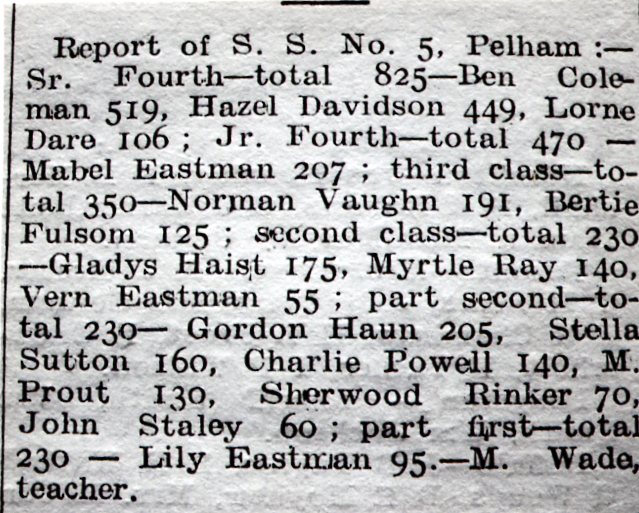
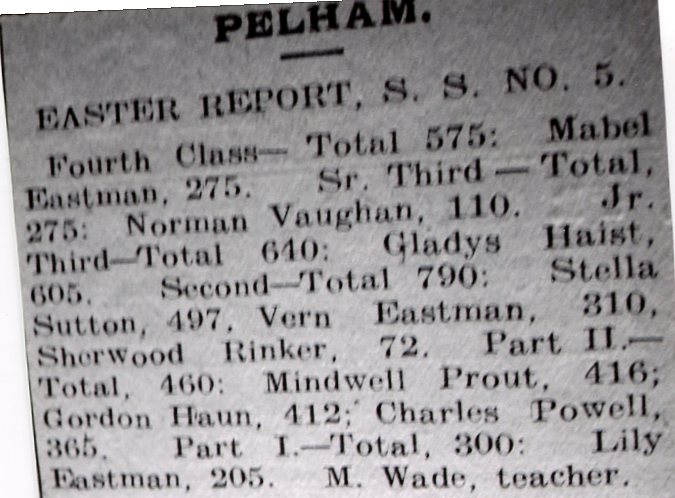


 Subscribe..
Subscribe..